Heir To The BX: 18 Pentium III Motherboards Using The 815 Chipset
Chaintech CT-6OJV

Board Revision:
BIOS Version:
Chaintech and Siemens do not equip the GMCH chip (Intel 815 Graphics and Memory Controller Hub) with a cooler. As the board does only support clock speeds up to 150 MHz, that's basically not necessary. Both the placement of the FDD connector and the DIMM sockets are not chosen very well. The floppy cable will interfere with almost any AGP card and the DIMM locks have to be closed in order to install memory.

6 PCI slots are ready for your hardware. The sound system uses the Crystal codec 4299 from Cirrus Logic. There is also an alternative version of the 6OJV available with a Creative sound chip. Three line-ins are on the motherboard, labeled as aux-in, mono-in and CD-in. And there is some margin left for a second flash chip; the manual calls this TwinBIOS technology. Unfortunately neither this chip nor the Creative sound system was equipped on our test sample. A nice detail is the integrated piezo speaker.
Chaintech included a so-called Instant Recovery Utility into the system BIOS. In a special sub-menu outside the regular BIOS you may backup or restore your system. The BIOS includes an item called hardware reset protect. I think you can imagine what this does: If you need to set up a presentation computer e.g. at a shopping center, you can prevent the system to reset after pushing the reset button without opening the case and removing the cable.
There are almost no jumpers on the board as the CPU setup is done in the SeePU BIOS sub menu. You may set FSB speeds of up to 150 MHz, but an item to alter the processor core voltage is missing. What I liked is the option to completely release the FDD interrupt in case you don't want a floppy drive.
Chaintech's motherboard passed all tests without any problem. The HSDRAM DIMM and the Viking module did not work at all, but all other types of SDRAM can be used. Inside the package you will merely find the necessary things: 80-pin IDE and FDD cable. A COM2 connector is missing and as far as I know, the version with two additional USB ports does not include the adapter cable either.
Both performance and stability are on a high level, just like we wanted to see it. The illustrated good manual will give you every interesting kind of information. You will also have to take a look into the manual before plugging in the power switch, power LED, reset and other cables, because they are not labeled at all on the board.
Stay on the Cutting Edge
Join the experts who read Tom's Hardware for the inside track on enthusiast PC tech news — and have for over 25 years. We'll send breaking news and in-depth reviews of CPUs, GPUs, AI, maker hardware and more straight to your inbox.
Chaintech boards are usually available for a nice price; if you can live with a little design weakness and without advanced overclocking features, you will get a reliable motherboard with lots of resources.
Most Popular

